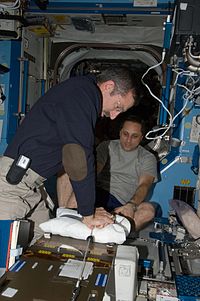
Photo from wikipedia
Introduction: The aim of this study was to examine differences between a control warm-up and an Electric Muscle Stimulation (EMS)-induced warm-up in off-road cyclists when examining anaerobic performance measures from… Click to show full abstract
Introduction: The aim of this study was to examine differences between a control warm-up and an Electric Muscle Stimulation (EMS)-induced warm-up in off-road cyclists when examining anaerobic performance measures from a repeated Wingate test (WAnT). Methods: Twelve trained off-road cyclists completed a randomized crossover study (age: 31 ± 10 years, height: 176.79 ± 6.09 cm, body mass: 74.57 ± 4.77 kg). Participants completed two randomized, separate testing sessions involving a control warm-up and an EMS warm-up before undergoing the repeated WAnT, which was used to collect anaerobic performance and physiolo- gical measures during both sessions. High-frequency EMS was applied to the knee extensor muscles for 4 min after a standardized warm-up during the EMS session. Results: Analysis revealed that there were no significant differences between mean power output, peak power output, and percentage decrement between the two sessions. The EMS session resulted in significantly lower average HR values and significantly lower differences in pre-to-post-test blood lactate values when compared to the control session. Discussion: According to the results of this study, an acute application of EMS is not a useful tool for off-road cyclists to improve power output or maintain anaerobic capacity. Hence, its use before competition is questionable.
Journal Title: Research quarterly for exercise and sport
Year Published: 2022
Link to full text (if available)
Share on Social Media: Sign Up to like & get
recommendations!